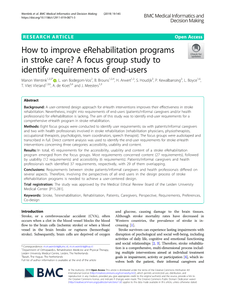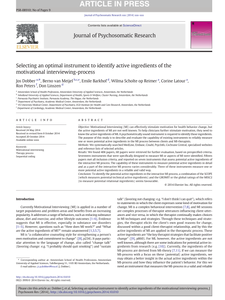The labor productivity of construction projects is low. This urges construction companies to increase their labor efficiency, particularly when demands grow and labor is scarce. This blog introduces an overview that helps practitioners identify causes of low productivity to find and eliminate the root causes.
LINK
Background: A user-centered design approach for eHealth interventions improves their effectiveness in stroke rehabilitation. Nevertheless, insight into requirements of end-users (patients/informal caregivers and/or health professionals) for eRehabilitation is lacking. The aim of this study was to identify end-user requirements for a comprehensive eHealth program in stroke rehabilitation. Methods: Eight focus groups were conducted to identify user requirements; six with patients/informal caregivers and two with health professionals involved in stroke rehabilitation (rehabilitation physicians, physiotherapists, occupational therapists, psychologists, team coordinators, speech therapist). The focus groups were audiotaped and transcribed in full. Direct content analysis was used to identify the end-user requirements for stroke eHealth interventions concerning three categories: accessibility, usability and content. Results: In total, 45 requirements for the accessibility, usability and content of a stroke eRehabilitation program emerged from the focus groups. Most requirements concerned content (27 requirements), followed by usability (12 requirements) and accessibility (6 requirements). Patients/informal caregivers and health professionals each identified 37 requirements, respectively, with 29 of them overlapping. Conclusions: Requirements between stroke patients/informal caregivers and health professionals differed on several aspects. Therefore, involving the perspectives of all end users in the design process of stroke eRehabilitation programs is needed to achieve a user-centered design.
MULTIFILE

Motivational Interviewing (MI) can effectively stimulate motivation for health behavior change, but the active ingredients of MI are not well known. To help clinicians further stimulate motivation, they need to know the active ingredients of MI. A psychometrically sound instrument is required to identify those ingredients. The purpose of this study is to describe and evaluate the capability of existing instruments to reliably measure one or more potential active ingredients in the MI process between clients and MI-therapists.
MULTIFILE

OBJECTIVE: Motivational Interviewing (MI) can effectively stimulate motivation for health behavior change, but the active ingredients of MI are not well known. To help clinicians further stimulate motivation, they need to know the active ingredients of MI. A psychometrically sound instrument is required to identify those ingredients. The purpose of this study is to describe and evaluate the capability of existing instruments to reliably measure one or more potential active ingredients in the MI process between clients and MI-therapists.METHODS: We systematically searched MedLine, Embase, Cinahl, PsycInfo, Cochrane Central, specialised websites and reference lists of selected articles.RESULTS: We found 406 papers, 60 papers were retrieved for further evaluation, based on prespecified criteria. Seventeen instruments that were specifically designed to measure MI or aspects of MI were identified. Fifteen papers met all inclusion criteria, and reported on seven instruments that assess potential active ingredients of the interactive MI process. The capability of these instruments to measure potential active ingredients in detail and as a part of the interactive MI process varies considerably. Three of these instruments measure one or more potential active ingredients in a reliable and valid way.CONCLUSION: To identify the potential active ingredients in the interactive MI process, a combination of the SCOPE (which measures potential technical active ingredients) and the GROMIT or the global ratings of the MISC2 (to measure potential relational ingredients) seems favourable.
DOCUMENT
Qualitative and quantitative research methods were used to establish the role of the website in the educational process of Bedrijfsmanagement MKB students, and the use of the website in the student recruitment process.
DOCUMENT
Aims and objectives: To determine a valid, reliable and clinical userfriendly instrument, based on predictors of functional decline, to identify older patients at risk for functional decline. The predictors of functional decline are initially considered and, subsequently, the characteristics and psychometric qualities of existing screening instruments are investigated. Background: Functional decline is a common and serious problem in older hospitalized patients, resulting in a change in quality of life and lifestyle. Studies have shown that 3060% of older people develop new dependencies in activities of daily living (ADL) during their hospital stay. Adverse health outcomes such as mortality, a prolonged hospital stay, nursing home placement and increased dependency of older people at home are the results. Not only are the personal costs high but also, in a rapidly growing older population, the impact on health-care costs is also high. Results: Age, lower functional status, cognitive impairment, preadmission disability in instrumental activities of daily life (IADL), depression and length of hospital stay were identified as predictors of functional decline. Three screening instruments to identify hospitalized patients at risk for functional decline were found in the literature: the Hospital Admission Risk Profile, the Identification of Seniors at Risk and the Care Complexity Prediction Instrument. The reported validity was moderate. Reliability and the ease of use in the clinical setting were not well described. Conclusion.: These three instruments should be further tested in a hospitalized older population. Relevance to clinical practice. Screening is a first step to identify patients at risk for functional decline and this will make it possible to treat patients who are identified so as to prevent functional decline. Because of their ability to observe and to guide the patients and the overall view they have, nurses play a key role in this process.
DOCUMENT
This study evaluates the concurrent validity of five malnutrition screening tools to identify older hospitalized patients against the Global Leadership Initiative on Malnutrition (GLIM) diagnostic criteria as limited evidence is available. The screening tools Short Nutritional Assessment Questionnaire (SNAQ), Malnutrition Universal Screening Tool (MUST), Malnutrition Screening Tool (MST), Mini Nutritional Assessment—Short Form (MNA-SF), and the Patient-Generated Subjective Global Assessment—Short Form (PG-SGA-SF) with cut-offs for both malnutrition (conservative) and moderate malnutrition or risk of malnutrition (liberal) were used. The concurrent validity was determined by the sensitivity, specificity, positive predictive value (PPV), negative predictive value (NPV), and the level of agreement by Cohen’s kappa. In total, 356 patients were included in the analyses (median age 70 y (IQR 63–77); 54% male). The prevalence of malnutrition according to the GLIM criteria without prior screening was 42%. The conservative cut-offs showed a low-to-moderate sensitivity (32–68%) and moderate-to-high specificity (61–98%). The PPV and NPV ranged from 59 to 94% and 67–86%, respectively. The Cohen’s kappa showed poor agreement (k = 0.21–0.59). The liberal cut-offs displayed a moderate-to-high sensitivity (66–89%) and a low-to-high specificity (46–95%). The agreement was fair to good (k = 0.33–0.75). The currently used screening tools vary in their capacity to identify hospitalized older patients with malnutrition. The screening process in the GLIM framework requires further consideration.
DOCUMENT

The liveability of cities worldwide is under threat by the predicted increase in intensity and frequency of heatwaves and the absence of a clear spatial overview of where action to address this. Heat stress impairs vital urban functions (Böcker and Thorsson 2014), hits the local economy (Evers et al. 2020), and brings risks for citizens’ health (Ebi et al. 2021). The ongoing densification of cities may escalate the negative consequences of heat, while rising climate adaptation ambitions require new pathways to (re)design public places for a warmer climate. Currently, policy makers and urban planners rely on remote sensing and modelling to identify potential heat stress locations, but thermal comfort models alone fail to consider socio-environmental vulnerabilities and are often not applicable in different countries (Elnabawi and Hamza 2020).In the Cool Towns Interreg project, researchers collaborated with municipalities and regions to model urban heat stress in nine North-Western European cities, to find vulnerabilities and to measure on the ground (see Spanjar et al. 2020 for methodology) the thermal comfort of residents and the effectiveness of implemented nature-based solutions. Using the Physiological Equivalent Temperature (PET) index, several meteorological scenarios were developed to show the urban areas under threat. The PET maps are complemented by heat vulnerability maps showing key social and environmental indicators. Coupled with local urban planning agendas, the maps allowed partner cities to prioritize neighbourhoods for further investigation. To this end, community amenities and slow traffic routes were mapped on top of the PET maps to identify potential focus areas.A comparative analysis of the collated maps indicates certain spatial typologies, where vital urban activities are often influenced by heat stress, such as shopping areas, mobility hubs, principal bicycle and pedestrian routes. This project has resulted in the development of a multi-level Thermal Comfort Assessment (TCA), highlighting locations where vulnerable user groups are exposed to high temperatures. Standardized for European cities, it is a powerful tool for policy makers and urban planners to strategically identify heat stress risks and prioritize locations for adapting to a changing climate using the appropriate nature-based solutions.
MULTIFILE

Promoting inclusive school cultures and, more specifically, addressing inequality of opportunity is high on the European education agenda. This is reflected in the policies and ambitions of many teacher training institutes. As inequality is part of a ‘wicked problem’, simply adding the theme to the curriculum is hardly a solution. Equipping teachers to be able to identify and address inequality of opportunity requires them to develop sensitivity, multi-perspectivity and agency, for instance, and these are complex attributes that require personal experiences and deep reflection.Recognizing this complexity, five master’s students chose this challenge for their collective graduate research project. Following the principles of design research, they developed a game that helps both beginning and experienced teachers reflect on the hidden mechanisms of inequality, particularly on the effects of socio-economic status (SES), and it stimulates them to address these mechanisms. In the card game, that is played by 3-5 teachers, each teacher first draws a persona card; each player ‘becomes’ a pupil with a given SES-background, and then gathers positive and negative experiences.This article reports on the impact of the game – both in terms of outcomes and in its driving mechanisms. To this end, the canvasses on which the individual participants recorded their learning outcomes were analyzed, as well as a retrospective questionnaire that was administered. The respondents (n = 90) were students in either initial teacher training programmes or post initial (master’s) programmes.The results are promising, especially on (a) identifying with low SES pupils and (b) feeling the accumulation of negative experiences which raises teachers’ awareness. The participants report that through the individual and collective reflections afterwards, they are better equipped to understand and address the issue.
LINK
This study focuses on SME networks of design and high-tech companies in Southeast Netherland. By highlighting the personal networks of members across design and high-tech industries, the study attempts to identify the main brokers in this dynamic environment. In addition, we investigate whether specific characteristics are associated with these brokers. The main contribution of the paper lies in the fact that, in contrast to most other work, it is quantitative and that it focuses on brokers identified in an actual network (based on both suppliers and users of the knowledge infrastructure). Studying the phenomenon of brokerage provides us with clear insights into the concept of brokerage regarding SME networks in different fields. In particular we highlight how third parties contribute to the transfer and development of knowledge. Empirical results show, among others that the most influential brokers are found in the nonprofit and science sector and have a long track record in their branch.
DOCUMENT
